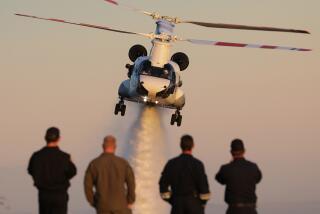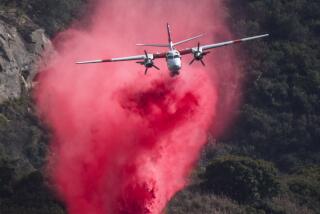When Construction Plans Are Up in the Air, So Are They
- Share via
From construction of the smallest housing tract to the largest industrial project, the work really begins about a mile above the planned site.
Almost every development requires a detailed contour map before regulatory approvals can be obtained, and such maps are drawn from the work of a modern surveying crew--a pilot and camera operator who take precision aerial photographs of the area planned for development.
It is not an easy job.
“You’ve got to be level and on the mark,” explained Marvin (Andy) Andelin, owner of Pacific Aerographics in Santa Ana, an aerial photography concern that has seven employees and two aircraft.
Using 230-pound cameras mounted on the floor of the aircraft, company pilots typically fly hundreds of miles each day around Southern California, taking turns as camera operator to squint through a viewfinder similar to the kind used by World War II bombardiers to site their targets.
Each day’s work is planned late in the previous afternoon, when rough maps of the areas to be photographed arrive from engineering companies around Southern California.
A recent day’s work for Pacific included assignments over Indio, Rialto, Santa Barbara, Grover City and Buellton. The nine-inch negatives usually are processed immediately after the crew returns from a day’s flight and the prints then are sent to map-making companies--which often use the aerial shots to turn out finished project maps in just a few days.
The Irvine Hilton, several buildings at UC Irvine and the Montebello Shopping Center are some of the completed projects that began with photos taken by Pacific.
Aerial photos also have other applications. In addition to pictures that are fitted into large mosaics of particular areas, Pacific also does “low sun angle” work for oil companies. Photographs taken in the early morning and late afternoon accentuate shadows, cast by certain geologic features, that give clues to potential oil deposits.
Airborne photographers haven’t replaced ground surveyors, who still must establish the courses that the pilots must fly. But for a mapping company, aerial photos can do in hours the work that would take a survey crew several days.
Taking precision aerial shots requires a camera that typically is worth far more than the airplane that carries it aloft. Pacific has two cameras, each of which cost about $150,000 and normally is loaded with a 200-exposure roll of black and white film costing $120.
Although the techniques used by Pacific and other aerial photographers have remained essentially the same for decades, “phenomenal” advances have been made in camera optics, Andelin said. Today’s lenses have virtually no distortion, he said, an important characteristic for cartographers--who typically have to make contour lines on their maps accurate to within three inches.
To generate a map of that accuracy, the cartographer must have pictures taken within 20 feet to the left or right of the course established by the ground-base survey team. Flying such a demanding course requires careful navigation, Andelin said.
In addition to future development sites, Pacific is taking pictures of 36 highway segments this year for the California Department of Transportation and also does aerial work for Thomas Bros. Maps, the Irvine company that makes map books for 28 counties.
The company also took photos for a map and photo book produced by Air Photo Services, a company that shares office and production space with Pacific. APS produced an Orange County map book that has the Thomas Bros. map plate on one page and the corresponding aerial photo on the facing page. In production now is a similar book of Los Angeles county.
More to Read
Sign up for Essential California
The most important California stories and recommendations in your inbox every morning.
You may occasionally receive promotional content from the Los Angeles Times.










